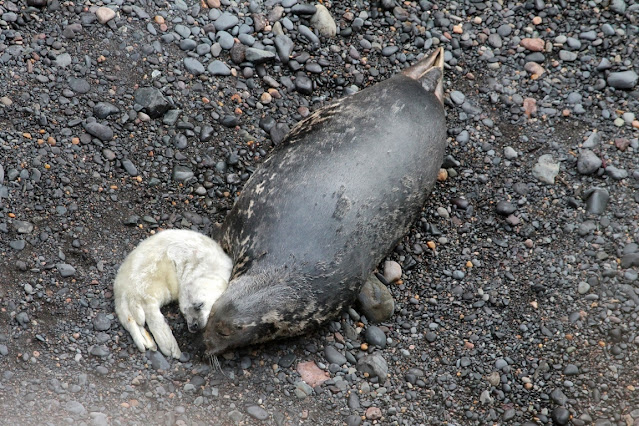Nestled at the very heart of Skomer Island lies an old converted farm building. Those of you who have visited Skomer will be familiar with the courtyard – complete with large picnic benches, and a burrow-free expanse (perfect for games of frisbee!). However, few will have ventured inside the buildings that our staff, volunteers, researchers, and overnight guests call home.
 |
| Sunset over the Farm © Skomer VO / WTSWW |
Staying overnight on Skomer is a magical experience – certainly not one to miss out on. At the time of writing, we currently have 2-night and 3-night stays available throughout August and September. Sometimes referred to as ‘the shoulder season’, this period is undoubtedly a favourite for many of our residents.
 |
| A peaceful evening at Garland Stone © Skomer VO / WTSWW |
Regardless of the time of year, a visit to Skomer provides the perfect chance to get away from the hustle and bustle of everyday life. With a maximum of just 16 overnight guests, there's always a quiet place or amazing wildlife encounter just round the corner. But just what might you see once puffin season comes to an end?
Wildlife
 |
| Small tortoiseshell butterfly © Skomer VO / WTSWW |
 |
| Seal pup and mum on one of Skomer's coves © Seal Project Officer / WTSWW |
 |
| Fulmar chick nestled along a ledge in North Haven © Skomer VO / WTSWW |
 |
| Common lizard sunning itself near the Farm © Skomer VO / WTSWW |
As we move to September, the mournful calls of seals echo around the cliffs during the day. The night, however, is very much owned by Skomer’s most numerous (and noisiest!) resident: the Manx shearwater. Manx shearwaters are present on Skomer from March until the end of October. This latter part of the year however (from late-August onwards), is arguably the most exciting time to see these night-time wanderers – in particular the fledglings. Adult Manx shearwaters raise a single chick, which spends much of its young life hidden underground, nestled in the safety of its burrow. As the chicks continue to grow, so too does their confidence. As they approach fledging, Manx shearwater chicks begin to emerge from their burrows at night, to practice flapping their large wings – building muscles that will be vital in carrying them all the way to the seas off South America! There is something very special about seeing a Manxie chick finally fledge, knowing full well that it will not touch ground again for at least 5 years, when it will hopefully return to Skomer to breed.
 |
| Raven numbers soar in September © Skomer Volunteer Warden / WTSWW |
 |
| Spotted flycatcher perching near the Farm © Skomer VO / WTSWW |
Throughout September, we also see (and hear!) huge flocks of ravens; as well as good numbers of migratory birds moving though, including wryneck, redstarts, and pied flycatchers.
This time
of year is truly magical, and not something to miss out on.
Facilities
 |
| The Farm © Skomer Assistant Warden / WTSWW |
Our hostel sleeps a maximum of 16-overnight guests, spread over 5 private rooms. Although basic, the hostel has everything you will need for the duration of your stay, including:
- Kitchen – fully equipped with gas ovens, a large chest fridge, sinks, pots and pans, and crockery and cutlery.
- Bathrooms – there are two bathrooms in the Hostel, complete with shower, sink, and flushing toilet!
- Lounge / Dining Room – spacious and comfortable. Here you will find tables and chairs, sofas, and a log burner.
How to
book
 |
| Sunrise from the Trig Point © Skomer Assistant Warden / WTSWW |
To book, or
for more information, please call our Bookings Team on 01656 724100. Please
note, the phone lines are only staffed between 10am – 4pm, Monday – Friday. Alternatively,
please email: islands@welshwildlife.org.
For more,
please visit - https://www.welshwildlife.org/skomer-island-overnight-stays.
Until next time. Wela i di wedyn!
Beth, Visitor Officer